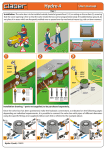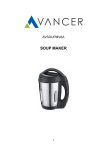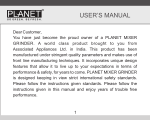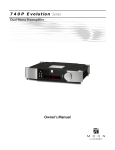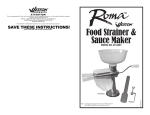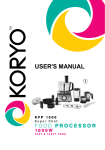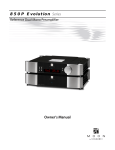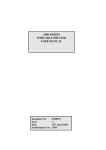Download TS-061 User Manual UK
Transcript
HOME ICE CREAM MAKER USER INSTRUCTION MANUAL MODEL TS-009AS TS-009AS Version 08/04 Page 1 of 8 Introduction This instruction manual covers the operation of the Home Ice Cream Maker Model TS-009AS. All versions of body colour and finish are covered by these instructions. Please read these instructions carefully prior to using the appliance for the first time, especially the ‘Hints, Tips and Important Safeguards’ section later in this manual. It is recommended that these instructions be retained for future reference. The appliance must be connected to a (nominally) 240V AC 50Hz. earthed electrical supply and be protected with a 13 Amp. fuse. The Ice Cream Maker has a mains electricity On/Off switch which is situated on the right lower rear of the appliance, and a START/STOP button on the Control Panel. The Home Ice Cream Maker can produce up to 1 litre, 35 fluid ounces, of ice cream at a time. Ingredients used should be foodstuff grade edible ingredients, and it is recommended that tried and tested recipes are used until familiarity with appliance operation is gained. A list of typical ingredients is given in the Hints, Tips and Important Safeguards section. Parts Overview Appliance Body Control Panel/Display Ice Cream Container Paddle Refrigeration Barrel Top Assembly D E TS-009AS Version 08/04 B Page 2 of 8 Preparing the Appliance for Use Unpack the appliance and place it on a sturdy level surface. It is recommended that the packaging is retained for secure movement/transport. The appliance operates at its optimum performance in a normal room temperature of 20º C. The refrigerant inside the appliance must have time to settle following transportation and a minimum stabilisation period of three hours is recommended prior to switching on the appliance. There are several ventilation grilles in the appliance cover mainly in the lower left hand and right hand sides. To ensure correct appliance operation these grilles must not be obstructed. A gap of at least 20 cm. (8 inches) must be maintained between the appliance sides, rear and top and other appliances or walls. As with all appliances used for the production of foodstuffs good basic hygiene and cleanliness practices are essential. Before use the appliance must be thoroughly cleaned in the following manner (items in BOLD are shown in Parts Overview): A. Carefully lift off the Top Assembly, remove the plastic Paddle by gently but firmly pulling on the Paddle. Lay the Top Assembly where it cannot be damaged or get wet. B. Remove the Ice Cream Container from the Refrigeration Barrel using the wire handle, the Container is a tight fit into the Barrel. Immerse the Container and the Paddle in clean warm soapy water. Wash both parts by hand and dry them. Appliance parts must not be washed with scourers in a dishwasher. C. Carefully wipe down the Top Assembly and the Appliance Body with a damp cloth. Dry both assemblies. Do not immerse the Top Assembly or the Appliance Body in water. D. Wipe the inside of the Refrigeration Barrel with a damp cloth and dry. E. Replace the Ice Cream Container in the Refrigeration Barrel. It is important to replace the Ice Cream Container in the correct position. The two lugs on the Container top rim to which the wire handle is fixed must align with the two cut-outs in the clear seal around the edge of the Refrigeration Barrel. The wire handle must also be folded towards the front of the appliance otherwise the Top Assembly may not seat correctly and the appliance may not work. (The two cut-outs in the seal are at approximately ’ten minutes past the hour’ and ‘twenty minutes to the hour’ when viewed from the front of the appliance.) F. Attach the Paddle to the Top Assembly and replace the Top Assembly onto the appliance. The appliance is now ready for use. TS-009AS Version 08/04 Page 3 of 8 Appliance Operation It is recommended that the Ice Cream Container is filled with a maximum volume of 1 litre (1000ml. or 35 fluid ounces) of, when possible, pre-mixed ingredients. This volume comes to approximately 4 centimetres (1½ inches) below the top edge of the Container. There are three reasons for this. Firstly ‘pre-mixed ingredients’ because some recipes may be written for different capacity appliances and simply adding a complete list of ingredients one at a time could overfill the Ice Cream Container causing it to overflow. Secondly pre-mixing ensures the ingredients are thoroughly mixed. Finally some ingredients can increase in volume as they freeze and leaving space for such expansion could avoid an overflow. Some recipes require small ingredients to be added during the freezing cycle and for such recipes a Small Ingredients Entry Cover is provided in the right hand side of the clear Perspex top cover. These ingredients should be added in accordance with recipe directions where given, or if no directions are given the softer the ingredient being added the nearer the end of the cycle it should be added to avoid it turning to mush. Care should be taken not to exceed the one litre appliance capacity when adding ingredients in this way and that the ingredients are chopped small enough to enter. If the recipe being followed would provide in excess of 1 litre of mixed ingredients then it should either be scaled down or any excess should be discarded. The storage of pre-mixed ingredients is not recommended. Remove the appliance Top Assembly and place carefully to one side. Remove the Ice Cream Container and pour in up to 1 litre of pre-mixed ingredients, this will fill the Container to approximately 4 cm. from its top rim. Replace the Ice Cream Container into the Refrigeration Barrel ensuring that it is fully inserted. The Ice Cream Container is a tight fit into the Refrigeration Barrel and it may be necessary to push down evenly on the Container rim to ensure it is fully inserted. It is important to replace the Ice Cream Container in the correct orientation. The two lugs on the Ice Cream Container top rim to which the wire handle is fixed must align with the two cut-outs in the clear rubber seal around the edge of the Refrigeration Barrel. The wire handle must also be folded towards the front of the appliance. (The two cut-outs in the seal are at approximately ’ten minutes past the hour’ and ‘twenty minutes to the hour’ when viewed from the front of the appliance.) If correct orientation and handle position are not maintained electrical connection to the paddle motor may not be made and the paddle might not turn. Replace the Top Assembly ensuring it is pushed down and squarely seated, and plug the appliance into a suitable electricity supply. Switch on the Mains On/Off switch on the lower right rear of the appliance. TS-009AS Version 08/04 Page 4 of 8 Appliance Operation (Continued) The Timer will illuminate and will show a random time between 0 and 60 minutes. The cycle time is programmable and by pressing the TIMER SET button the displayed time will count down from its switch on value to zero and then reset to its maximum of 60 minutes and continue counting down. It is suggested that a time of 25 minutes is used as an initial cycle time, unless it is known that the particular recipe being used requires a longer time. Press the START/STOP button keeping it depressed for a couple of seconds. Release the START/STOP button, the appliance will bleep once, the paddle will begin to turn and the ice cream making cycle will start. If the paddle does not turn switch the appliance off at the START/STOP button then the mains On/Off switch, lift the Top Assembly off, ensure the Container is correctly orientated and its handle is folded forward and then replace the Top Assembly. Switch the appliance on again at the mains On/Off switch and reprogramme the required cycle time if necessary. Re-start by pressing the START/STOP button. The appliance can be stopped and re-started in its cycle by using the START/STOP button. Re-starting will reset the timer to its original start value. At the end of the ice cream making cycle the appliance will buzz five times, the paddle will continue turning and the freezing mode will be maintained so that the ice cream remains cold. It is recommended that the ice cream is removed as soon as possible after the end of the cycle. If the ice cream is not removed and the appliance is left for an extended period there is a possibility that the paddle could get frozen into the ice cream. Some experimentation with timings may be necessary to obtain a product of acceptable quality and consistency because variation in ingredients, temperatures and timings can lead to variation in the finished product. As soon as possible after the cycle has finished switch the mains switch off and unplug the appliance from the mains. Remove the Top Assembly and place carefully to one side. Remove the Ice Cream Container from the Refrigeration Barrel and scoop out the ice cream using a plastic or wooden spatula or spoon. Metal implements must not be used as they will damage the Container finish. If the ice cream is to be kept it should be placed into a suitable freezer container and stored in a freezer, as with commercial product. Clean and dry the appliance as in ‘Preparing the Appliance for Use’ section and allow the appliance to rest for a minimum of 5 minutes before starting another ice cream making cycle. TS-009AS Version 08/04 Page 5 of 8 After Use Disconnect from the electricity supply after use and clean and dry the appliance as in the ‘Preparing the Appliance for Use’ section. Remember the importance of hygiene and cleanliness. If the appliance is not to be used for more than a few hours it should be cleaned again immediately prior to making further batches of ice cream. Hints, Tips and Important Safeguards Do not place the appliance on its side or upside down. Pay particular attention to this when the appliance is being moved. During use ventilation grilles must not be obstructed. Do not immerse the appliance in water or other liquids. The appliance has internal moving parts. Take particular care to prevent children from getting access to or playing with the appliance. The Refrigeration Barrel is very cold and touching it could result in ice burns. Orientation of the Ice Cream Container within the Refrigeration Barrel must be correct. See the ‘Appliance Operation’ section. The appliance is designed for indoor use only. Do not expose the appliance to rain and do not use it or store it where it could get damp or wet. Do not put the appliance or its mains lead near heat sources such as cookers, hobs or ovens. Do not trail the lead over sharp corners or edges. In case of damage to the appliance or its lead we advise not using the appliance and to return it for authorised repair and parts replacement. Using parts not recommended by the manufacturer can be dangerous. Only use the appliance for its intended purpose, the production of ice cream. There are no user accessible parts inside the appliance casing so entry must not be attempted. The refrigerant gas used in the appliance (R134a) is chemical waste. Disposal of the appliance must be done in a proper environmentally friendly way. Inquire about proper disposal with your municipal waste processing department. TS-009AS Version 08/04 Page 6 of 8 Hints, Tips and Important Safeguards (Continued) Typical ingredients that can be used in the Ice Cream Maker are:Milk Heavy/Double Cream Single Cream Whipping Cream Sugar Egg/Egg Yolk Vanilla Extract Cocoa Powder Chopped Fruit Chopped Nuts Fruit Purees Grated Chocolate Crushed Biscuits Breadcrumbs Fruit Syrup This list is not meant to be exhaustive. Any foodstuff suitable for human consumption can be used. Solid foodstuffs like fruit and vegetables should be chopped small to avoid jamming and putting excessive strain on the paddle and its motor drive. A recipe booklet is supplied with this product which gives a range of tasty and interesting ice cream recipes to enjoy. Additional delicious, and some unusual, recipes can be found on www.ice-cream-recipes.com Service and Parts Assistance For advice or help on any matter please contact :- TS-009AS Version 08/04 Page 7 of 8 Appliance Technical Data Voltage: Maximum Power: Capacity: Cycle Time: Dimensions (mm): Net Weight: 240V AC 50Hz. 160W 1 litre (35 fluid ounces) per cycle 0 to 60 minutes programmable 310H x 280W x 380D 14.2Kg. Approvals: CE. TÜV/GS. UL approval pending. TS-009AS Version 08/04 Page 8 of 8









